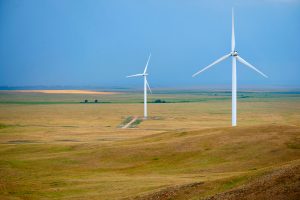On the sidelines of COP28, the U.N. climate change conference, Kazakhstan heralded its efforts to put wind in the sails of its own energy transition. Kazakhstan inked a new agreement with the host United Arab Emirates’ state-owned renewables company, Masdar, on December 2 for the development of a 1 gigawatt wind power project in the Central Asian state.
This follows two other wind farm projects announced earlier in 2023, including the Mirny wind farm project with France’s TotalEnergies and a deal with Saudi Arabia’s ACWA Power for a wind farm and battery storage project.
In June, TotalEnergies signed a Power Purchase Agreement (PPA) for the Mirny project – a 1 GW onshore wind farm paired with a 600 MWh battery storage system – with the Financial Settlement Center (FSC) of Renewable Energy, a public entity owned by the Kazakh government, which will buy the energy generated and supply the national grid. Per a press release, “TotalEnergies will develop the Mirny project in partnership with the National Wealth Fund Samruk-Kazyna and the National Company KazMunayGas, which will each own a 20% stake in the project.” The project, TotalEnergies said, represents a $1.4 billion investment.
A few days after the French deal was announced in June, a roadmap agreement was signed between ACWA Power, Kazakhstan’s Energy Ministry, and Samruk-Kazyna. The project appears tp have similar parameters: a 1 GW wind project, with attendant battery storage, and an investment of $1.5 billion. The ACWA deal, however, also marks the Saudi company’s entry into the Kazakh market.
“There is extraordinary potential for wind and solar power in my country as well as for green hydrogen. We will continue to work closely with our partners to unlock it,” Kazakh President Kassym-Jormart Tokayev said in remarks at COP28. Tokayev also highlighted Kazakhstan’s “crucial role in carbon-free electricity generation” as the world’s leading exporter of uranium.
“Indeed, as the world decarbonizes in the coming decades, critical minerals – including Rare Earth Metals – will become indispensable. Kazakhstan is poised to become a major supplier of these transition minerals,” Tokayev said.
Kazakhstan, and indeed Central Asia, is not often cited as a major source of critical minerals – from rare earths to minerals such as copper, cobalt, lithium, nickel, and graphite. A 2023 Critical Minerals Market Review published by the International Energy Agency (IEA) laid out the top producing countries of various minerals; not a single Central Asian state makes the list. China meanwhile, mines 86 percent of rare earths and 70 percent of graphite; almost half of all nickel is mined in Indonesia and an astonishing 74 percent of cobalt is mined in the Democratic Republic of the Congo (DRC). When it comes to processing, China tops every mineral mentioned in the report.
Nevertheless, it may be a lack of exploration at fault rather than a lack of goods beneath the steppe. At the historic C5+1 Leaders Meeting, in which U.S. President Joe Biden met with the five Central Asian presidents on the sidelines of the U.N. General Assembly in September, one of the meeting’s outcomes was a commitment to establish a C5+1 Critical Minerals Dialogue to “further develop Central Asia’s vast mineral wealth and advance critical minerals security.”
Kazakhstan has long been viewed as an oil- and gas-rich nation, and it is. Make no mistake, Kazakhstan remains a major producer of fossil fuels and a large portion of the Kazakh economy is tied up in the energy business. And yet, as Assel Tutumlu and Farkhod Aminjonov laid out in a recent article, like the rest of the energy-rich region, Kazakhstan has struggled to keep the lights and heat on in winter at times. The great Central Asian energy paradox is that while supplies are plentiful, the infrastructure is failing; it’s both more lucrative and faster to sell fuel than it is to fix the region’s grids.
Renewables are envisioned as both a salve for the energy crisis and also a necessary aspect of the transition away from fossil fuels, but neither goal is achievable with a crumbling grid.
A 2022 OSCE report, “Advancing Energy Security in Central Asia,” dubbed Astana the region’s leader on renewables, noting that Kazakhstan “has established clear targets for the use of renewables – solar, wind, biomass, and small hydropower – in its energy mix: 3 percent of total generation by 2020, 10 percent by 2030 and 50 percent by 2050.”
But even with the three wind projects announced this year, Kazakhstan has a long way to go for renewables to catch up or replace fossil fuels. The OSCE report cautioned: “Meeting Kazakhstan’s next renewable energy targets will require much larger investments from both the government and the private sector, in the range of US$54.6 billion to US$96.2 billion over the 2015–2045 period.”
Every little bit helps, however, and Astana certainly hopes to build on the French, UAE, and Saudi projects to achieve its ambitious goals.

































